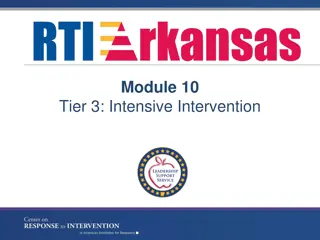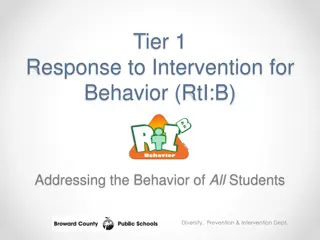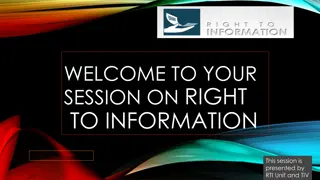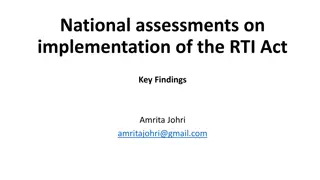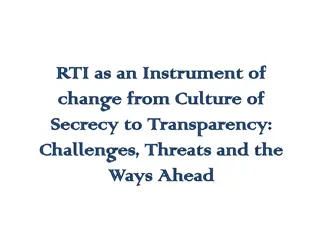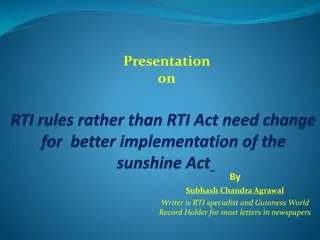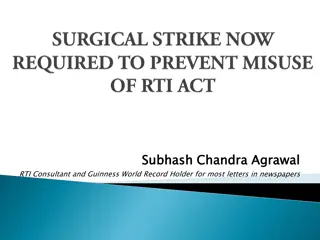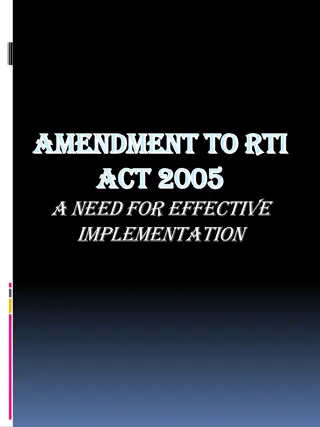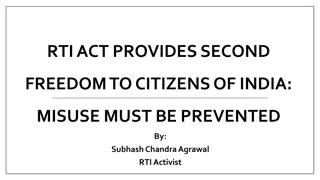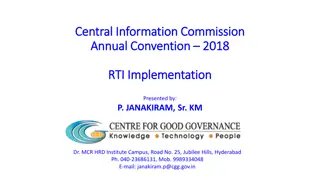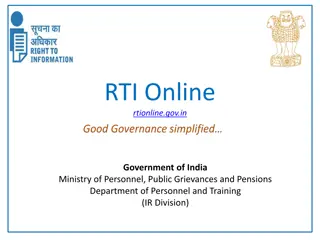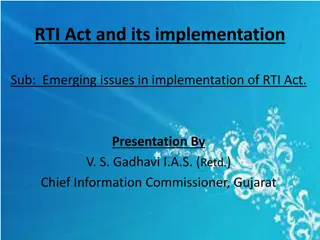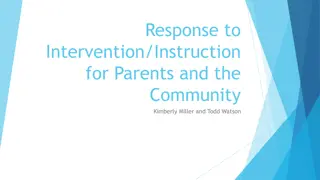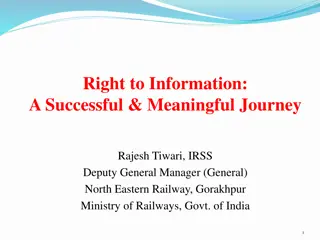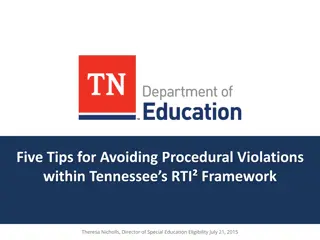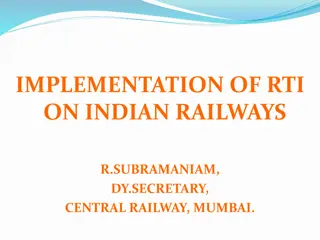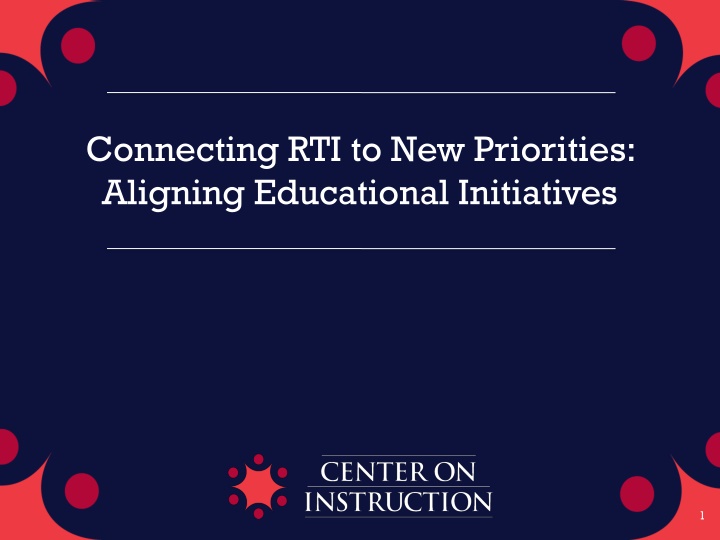
Connecting RTI to Educational Priorities: Aligning Initiatives for Success
Explore the alignment of Response to Intervention (RTI) with new educational priorities, covering a brief project history, dynamic inputs, common themes, recommendations for technical assistance, and more.
Download Presentation

Please find below an Image/Link to download the presentation.
The content on the website is provided AS IS for your information and personal use only. It may not be sold, licensed, or shared on other websites without obtaining consent from the author. If you encounter any issues during the download, it is possible that the publisher has removed the file from their server.
You are allowed to download the files provided on this website for personal or commercial use, subject to the condition that they are used lawfully. All files are the property of their respective owners.
The content on the website is provided AS IS for your information and personal use only. It may not be sold, licensed, or shared on other websites without obtaining consent from the author.
E N D
Presentation Transcript
Connecting RTI to New Priorities: Aligning Educational Initiatives 1
Disclaimer The Center on Instruction is operated by RMC Research Corporation in partnership with the Florida Center for Reading Research at Florida State University; Instructional Research Group; Lawrence Hall of Science; the Texas Institute for Measurement, Evaluation, and Statistics at the University of Houston; and The Meadows Center for Preventing Educational Risk at the University of Texas at Austin. The contents of this PowerPoint were developed under cooperative agreement S283B050034 with the U.S. Department of Education. However, these contents do not necessarily represent the policy of the Department of Education, and you should not assume endorsement by the Federal Government. The Center on Instruction requests that no changes be made to the content or appearance of this product. To download a copy of this document, visit www.centeroninstruction.org. 2011 2
Agenda Brief History of the Project Overview of the System Dynamic inputs: Policy Dynamic inputs: Standards Desired outputs: Diverse Learners Common Themes Across Topics Recommendations for TA Next Steps Final Thoughts Questions (followed by offline discussion) 3
History of the Project RTI Workgroup Eight state departments: Alaska, California, Idaho, Mississippi, Pennsylvania, Texas, Vermont, and Wyoming Seven Regional Comprehensive Centers (RCCs): Alaska, California, Northwest, Southeast, Mid-Atlantic, Texas, and New England 4
Working Meeting: RTI and State Priorities: Aligning Educational Initiatives Pre-Meeting Survey to determine highest priority areas: SIG/School Turnaround Diverse Learners Students with Disabilities English language learners College and Career Readiness Common Core State Standards 5
Dynamic Inputs Policy Funding Standards Curricula Assessments/accountability requirements 7
Robust Instructional System Efficient allocation of resources Evidence-based practices Effective instruction Effective assessment Data-based instructional decision-making 8
Desired Outputs All students graduate College and Career Ready English language learners Struggling students Students with disabilities Gifted and talented 9
School Improvement Grants Provision of funding to support improvement of the persistently lowest-achieving schools Intervention Models Turnaround model Restart model School closure Transformation model 11
SIG Alignment with RTI RTI is a framework for resource allocation (time, materials, staff, other resources) SIG is a funding source designed to support school improvement SIG funds can be (and in many cases are being) used to implement an RTI framework to achieve school improvement Transformation Model Turnaround Model
SIG Big Ideas Create, communicate, and disseminate explicit connections between SIG and RTI for RCCs, SEAs, & LEAs Support collaboration Provide capacity-building and sustainability at all levels Identify implementation tools 13
SIG and RTI Response to intervention model1 School improvement grants transformation/turnaround model2 Aligning the goals and vision for response to intervention (RTI) implementation with other educational initiatives, including developing guidance for districts and schools, defining the relationship between RTI and other statewide educational goals and initiatives, and exploring the potential role of RTI in identifying students with learning disabilities and/or eligibility for special education services Implementing a schoolwide RTI model Ensuring all stakeholders on the state-level RTI implementation team comprehensive representation and equal voice in conducting and developing team meetings and procedures Monitoring and/or evaluating implementation successes and challenges, needs assessments, and fidelity of implementation Conducting periodic reviews to ensure that the curriculum is implemented with fidelity, is having the intended impact on student achievement, and is modified if ineffective 14
SIG and RTI Response to intervention model1 School improvement grants transformation/turnaround model2 Acknowledging and preparing for new roles and responsibilities that come with implementing, building consensus, allocating resources, providing/seeking technical assistance, scaling up from initial to full implementation, running pilot/demonstration/model sites (if any), and conducting professional development at all levels, including state and school personnel and preservice teachers Providing staff members with ongoing, high- quality, job-embedded professional development that aligns with the school s comprehensive instructional program and that is designed with school staff members to allow them to facilitate effective teaching and learning and successfully implement school reform strategies Providing additional supports and professional development to teachers and principals on implementing effective strategies to support students with disabilities in the least restrictive environment and to ensure that limited English proficient students acquire language skills to master academic content 15
SIG and RTI Response to intervention model1 School improvement grants transformation/turnaround model2 Understanding, identifying, and implementing the instructional components of RTI at the school level (such as core instruction, interventions, screening and progress-monitoring assessments, data-based decision making, data management, and reporting systems) Identifying trainers, coaches, and implementation sites (which are not necessarily the same as model/pilot/demonstration sites, but are any districts and schools that wish to or are already implementing RTI) Using data to identify and implement an instructional program that is research based, vertically aligns from one grade to the next, and aligns with state academic standards Promoting the continuous use of student data (such as from formative, interim, and summative assessments) to inform and differentiate instruction to meet the academic needs of individual students Establishing schedules and implementing strategies that provide increased learning time Using and integrating technology-based supports and interventions as part of the instructional program 1All items in column adapted from Center on Instruction. (2008). Implementation considerations. In Response to intervention classification tool and response locator. Retrieved from http://www.rtictrl.org/considerations.php 2All items in column adapted from U.S. Department of Education, Office of Elementary and Secondary Education. (2010). Guidance on fiscal year 2010 school improvement grants under section 1003(g) of the Elementary and Secondary Education Act of 1965. Washington, DC: Author. 16
Self Reflection: 1. In your state, where do you see the connections between SIG and RTI? How is alignment between RTI and SIG being communicated to SEAs and/or LEAs? 2. 17
Resources Center on Instruction (n.d.). Selected COI resources addressing the ARRA reform area: Data systems to support instruction. Retrieved from http://www.centeroninstruction.org/selected-coi-resources-addressing-the-arra-reform-area- data-systems-to-support-instruction Center on Instruction (n.d.). Selected COI resources addressing the ARRA reform area: Effective leaders and teachers. Retrieved from http://www.centeroninstruction.org/selected-coi-resources- addressing-the-arra-reform-area-effective-leaders-and-teachers Center on Instruction (n.d.). Selected COI resources addressing the ARRA reform area: Standards and assessments. Retrieved from http://www.centeroninstruction.org/selected-coi-resources- addressing-the-arra-reform-area-standards-and-assessments Center on Instruction (n.d.). Selected COI resources addressing the ARRA reform area: Turning around struggling schools. Retrieved from http://www.centeroninstruction.org/selected-coi- resources-addressing-the-arra-reform-area-turning-around-struggling-schools Perlman, C. L., & Redding, S. (Ed.). (2009). Handbook on effective implementation of school improvement grants. Lincoln, IL: Academic Development Institute. Retrieved fromhttp://www.centerii.org/handbook/ U. S. Department of Education. School TurnaroundNewsletters. Retrieved from http://www.ed.gov/oese-news/school-turnaround-newsletters 18
Common Core State Standards Standards Grade Level/Cluster Standards (cumulative) Content Areas Math English Language Arts & Literacy in History/Social Studies, Science & Technical Subjects Cumulative Standards that lead to College & Career Readiness High Cognitive Demand State/District/School Defined Curriculum & Instructional Strategies 20
CCSS Alignment with RTI Large range of students will be expected to obtain mastery of the CCSS. RTI is one model for meeting all of their needs: Research-based core instruction for all students Ongoing data collection and data-based decision making to monitor student mastery of standards Intervention for students who don t master foundational reading skills Intervention for students who do not master grade level standards
CCSS Big Ideas Leadership is the key to using RTI to implement CCSS or other state standards and assessments Show explicit linkage between RTI and CCSS Capacity-building to ensure sustainability RTI as a systematic framework for implementing CCSS or other state standards and assessments 22
CCSS and RTI Elements of RTI State standards Common core state standards Universal screening Brief assessments that are valid, reliable, and demonstrate diagnostic accuracy for which students will develop learning or behavioral problems Brief assessments that are valid, reliable, and demonstrate diagnostic accuracy for which students will develop learning or behavioral problems Progress monitoring Repeated measurement of performance to inform the instruction of individual students in general and special education; tools should be reliable and valid for representing students development and have demonstrated utility for helping teachers plan more effective instruction Repeated measurement of performance to inform the instruction of individual students in general and special education; tools should be reliable and valid for representing students development and have demonstrated utility for helping teachers plan more effective instruction 23
CCSS and RTI Elements of RTI State standards Common core state standards Data-based decision making The use of screening, progress monitoring, and formative data to examine the adequacy of the core curriculum as well as the effectiveness of different instructional and behavioral strategies for various groups of students within a school The use of screening, progress monitoring, and formative data to examine the adequacy of the core curriculum as well as the effectiveness of different instructional and behavioral strategies for various groups of students within a school Primary prevention (core instruction) Includes the research-based core curriculum and instructional practices used for ALL students; even students who require supplemental interventions should receive instruction in the core curriculum Includes the research-based core curriculum and instructional practices used for ALL students; even students who require supplemental interventions should receive instruction in the core curriculum 24
CCSS and RTI Elements of RTI State standards Common core state standards Secondary prevention Typically, small-group instruction that relies on evidence-based interventions that specify the instructional procedures, duration, and frequency of instruction Typically, small-group instruction that relies on evidence-based interventions that specify the instructional procedures, duration, and frequency of instruction Tertiary prevention Most intense of the three levels; individualized instruction to target each student s area(s) of need Most intense of the three levels; individualized instruction to target each student s area(s) of need All items adapted from National Center on Response to Intervention. (2010). Essential components of RTI A closer look at response to intervention. Washington, DC: U.S. Department of Education, Office of Special Education Programs, National Center on Response to Intervention. 25
Self Reflection: 1. How can the current RTI infrastructure in your state be used to support the implementation of CCSS or other state standards and assessments? Even though the essential components of RTI remain the same under CCSS or other state standards, how will practices within each of these components need to be modified when implementing new state standards and assessments? 2. 26
Resources Common Core State Standards Initiative. (n.d.). Application of common core state standards for English language learners. Retrieved from www.corestandards.org/assets/application-for-english-learners.pdf Common Core State Standards Initiative. (n.d.). Application to students with disabilities. Retrieved from www.corestandards.org/assets/application-to-students-with-disabilities.pdf Common Core State Standards Initiative. (2010). Common core state standards for English language arts & literacy in history/social studies, science, and technical subjects. Common Core State Standards Initiative. (2010). Common core state standards for mathematics. Link to all CCSS resources on the COI site: http://www.centeroninstruction.org/resources_searchresults.cfm?searchterms=Common%20Core%20Sta te%20Standards&explicit=1 Consortia Developing Assessments Partnership for Assessment of Readiness for College and Careers (PARCC) http://www.achieve.org/PARCC SMARTER Balanced Assessment Consortium (SBAC) http://www.k12.wa.us/smarter/ Consortia Developing Alternate Assessment Dynamic Learning Maps http://dynamiclearningmaps.org/ National Center and State Collaborative http://www.cehd.umn.edu/nceo/projects/NCSC/NCSC.html *This webinar provides a good overview of the two consortia developing the alternate assessments: http://media.all4ed.org/webinar-jul-25-2011 27
College and Career Readiness for English Language Learners 28
English Language Learners ELLs must have access to1: Qualified personnel to support ELLs while taking advantage of the many strengths and skills they bring to the classroom; Literacy-rich school environments where students are immersed in a variety of language experiences; Instruction that develops foundational skills in English and enables ELLs to participate fully in grade-level coursework; Coursework that prepares ELLs for postsecondary education or the workplace, yet is made comprehensible for students learning content in a second language (through specific pedagogical techniques and additional resources); Opportunities for classroom discourse and interaction that are well-designed to enable ELLs to develop communicative strengths in language arts; Ongoing assessment and feedback to guide learning; and Speakers of English who know the language well enough to provide ELLs with models and support. 1National Governors Association Center for Best Practices & Council of Chief State School Officers (2010). Application of Common Core State Standards for English Language Learners. Retrieved from: http://www.corestandards.org/the-standards 29
ELL Alignment with RTI Compared to traditional instructional methods, instruction in RTI: May be less biased and more instructionally relevant May lead to earlier identification and intervention 1May help decrease proportions of ELLs inappropriately referred for special education 1Klingner, J. K., & Edwards, P. A. (2006). Cultural considerations with response to intervention models. Reading Research Quarterly, 41, 108-117. 30
ELL Alignment with RTI Could some of the same problems associated with traditional models emerge in RTI? Ex. Disproportionate numbers of ELLs receiving Tier II and III intervention if they perform below criteria established for non-ELLs Is this really a problem? Not if: Intensive instruction is beneficial for ELLs General classroom instruction (Tier 1) can be designed to meet the needs of ELLs, such that the most intensive interventions are reserved for the most struggling students 31
ELL Big Ideas Focus on instruction in Tier I Collaboration among teachers and across departments (content areas); Collaboration among other professionals Instill common vision that is embedded within the culture Formative assessments 32
Self Reflection: 1. How are the needs of ELLs being addressed in primary prevention (i.e., core instruction) in your state? What are areas in need of improvement with respect to instruction, assessment, data-based decision making and teacher preparation? 2. 33
Resources Echevarria, J., & Hasbrouck, J. (2009, July). Create Brief: Response to Intervention and English Learners. Retrieved from http://www.cal.org/create/resources/pubs/responsetointerv.html Esparza Brown, J., & Sanford, A. (March 2011). RTI for English Language Learners: Appropriately Using Screening and Progress Monitoring Tools to Improve Instructional Outcomes. Washington, DC: U.S. Department of Education, Office of Special Education Programs, National Center on Response to Intervention. Retrieved from http://www.rti4success.org/resourcetype/rti-english-language-learners-appropriately-using-screening-and- progress-monitoring-too Gersten, R., Baker, S. K., Shanahan, T., Linan-Thompson, S., Collins, P., & Scarcella, R. (2007). Effective Literacy and English Language Instruction for English Learners in the Elementary Grades: A Practice Guide (NCEE 2007-4011). Washington, DC: National Center for Education Evaluation and Regional Assistance, Institute of Education Sciences, U. S. Department of Education. Retrieved from http://ies.ed.gov/ncee/wwc/publications/practiceguides/ Meadows Center for Preventing Educational Risk at the University of Texas at Austin. (2010) Instructional decision- making procedures: Ensuring appropriate instruction for struggling students in Grades K-3. Austin, TX: Author. Retrieved from buildingrti.utexas.org/PDF/Instructional_Decision-making_Procedures.pdf Pennsylvania Department of Education. (n.d.). Response to instruction and intervention (RtII) and English language learners (ELLs). Retrieved from http://www.pattan.net/category/Resources/PaTTAN%20Publications/Browse/Single/?id=4dc09560cd69f9ac7fb400 00 Center for Research on the Educational Achievement and Teaching of English Language Learners(CREATE) http://www.cal.org/create/index.html The George Washington University Center for Equity and Excellence in Education ELL Accommodations Online Toolkit and Database http://ells.ceee.gwu.edu/tools.aspx World-Class Instructional Design and Assessment (WIDA) http://www.wida.us/index.aspx 34
Resources Link to all ELL resources on the COI site: http://www.centeroninstruction.org/topic.cfm?k=ELL Examples: Moughamian, A. C., Rivera, M. O., & Francis, D. J. (2009). Instructional models and strategies for teaching English language learners. Portsmouth, NH: RMC Research Corporation, Center on Instruction. Retrieved from http://www.centeroninstruction.org/instructional-models-and- strategies-for-teaching-english-language-learners Rivera, M. O., Moughamian, A. C., Lesaux, N. K., & Francis, D. J. (2008). Language and reading interventions for English language learners and English language learners with disabilities. Portsmouth, NH: RMC Research Corporation, Center on Instruction. Retrieved from http://www.centeroninstruction.org/language-and-reading-interventions-for-english-language- learners-and-english-language-learners-with-disabilities Rivera, M. O., Francis, D. J., Fernandez, M., Moughamian, A. C., Lesaux, N. K., & Jergensen, J. (2010). Effective practices for English language learners. Principals from five states speak. Portsmouth, NH: RMC Research Corporation, Center on Instruction. Retrieved from http://www.centeroninstruction.org/effective-practices-for-english-language-learners-principals- from-five-states-speak 35
College and Career Readiness for Students with Disabilities 36
Students with Disabilities Students with disabilities must have access to1: Rigorous academic content standards; Adequate preparation for success in college and/or careers; Supports and related services designed to meet their needs Supports and related services designed to enable their access to the general curriculum; Individualized Education Programs with annual goals aligned with and chosen to facilitate their attainment of grade-level academic standards; Teachers who are prepared and qualified to deliver high-quality, evidence- based, individualized instruction and support services; Specialized instructional support personnel who are prepared and qualified to deliver high-quality, evidence-based, individualized instruction and support services; and Appropriate additional supports and services (e.g., Universal Design for Learning, instructional accommodations, or assistive technology devices). 1National Governors Association Center for Best Practices & Council of Chief State School Officers (2010). Application to Students with Disabilities. Retrieved from: http://www.corestandards.org/the-standards 37
SWD Alignment with RTI Data-driven instructional decision-making Early intervention rather than wait-to-fail Differentiated instruction for ALL students Increased collaboration and shared ownership between departments and eds Referral and eligibility in the context of evidence More efficient and appropriate allocation of resources 38
SWD Big Ideas Purposes and goals of RTI need to be made explicit to all stakeholders Need for RTI to be implemented systematically and systemically Early involvement of parents Usefulness of infusing the language of RTI into all trainings/PD done at the state level 39
Self Reflection: Is there a need in your state for better or more communication between general and special educators? Are there advantages to you in using RTI as an instructional framework for preparing students for college and careers? How are parents and other stakeholders being made aware of RTI? 1. 2. 3. 40
Resources Boardman, A. G., Roberts, G., Vaughn, S., Wexler, J., Murray, C. S., & Kosanovich, M. (2008). Effective instruction for adolescent struggling readers: A practice brief. Portsmouth, NH: RMC Research Corporation, Center on Instruction. Retrieved from http://www.centeroninstruction.org/effective-instruction-for-adolescent-struggling- readers---second-edition Gersten, R. Chard, D., Jayanthi, M., Baker, S., Morphy, P., & Flojo, J. (2008). Mathematics instruction for students with learning disabilities or difficulty learning mathematics: A synthesis of the intervention research. Portsmouth, NH: RMC Research Corporation, Center on Instruction. Retrieved from http://www.centeroninstruction.org/mathematics-instruction-for-students-with-learning-disabilities-or-difficulty- learning-mathematics-a-synthesis-of-the-intervention-research Meadows Center for Preventing Educational Risk at the University of Texas at Austin. (2010) Instructional decision- making procedures: Ensuring appropriate instruction for struggling students in Grades K-3. Austin, TX: Author. Retrieved from buildingrti.utexas.org/PDF/Instructional_Decision-making_Procedures.pdf Newman-Gonchar, R., Clarke, B., & Gersten, R. (2009). A summary of nine key studies: Multi-tier intervention and response to interventions for students struggling in mathematics. Portsmouth, NH: RMC Corporation, Center on Instruction. Retrieved from http://www.centeroninstruction.org/a-summary-of-nine-key-studies-multi-tier- intervention-and-response-to-interventions-for-students-struggling-in-mathematics Scammacca, N., Vaughn, S., Roberts, G., Wanzek, J., & Torgesen, J. K. (2007). Extensive reading interventions in grades k-3: From research to practice. Portsmouth, NH: RMC Research Corporation, Center on Instruction. Retrieved from http://www.centeroninstruction.org/extensive-reading-interventions-in-grades-k-3-from-research- to-practice Torgesen, J. K., & Miller, D. H. (2009). Assessments to guide adolescent literacy instruction. Portsmouth, NH: RMC Research Corporation, Center on Instruction. Retrieved from http://www.centeroninstruction.org/assessments-to- guide-adolescent-literacy-instruction 41
Common Themes Across Topics RTI can be used to implement the priorities and support school improvement Explicit links need to be made between RTI and the priorities to support collaboration Leadership is key to implementation Need to address sustainability 42
Recommendations for TA Promote statewide coherence by showing explicit connections between RTI and state priorities: Align different priorities around the common framework of RTI (increase efficiency and effectiveness and promote coherence) Provide different divisions within the state agency opportunities to talk together about RTI and state priorities Ensure that different divisions within the state agency use common language when talking about RTI 43
Next Steps Action planning template 44
Final Thoughts Focus on state leaders keep RTI in the front seat Include implications for districts and schools Work with each other on action planning template 45
Questions? Please ask general questions in the chat area For more focused/specific discussion, we will turn off the recording in a bit 46
Thank you! Please take a moment to complete our evaluation survey: http://www.surveymonkey.com/s/VL2TTQ9 47

